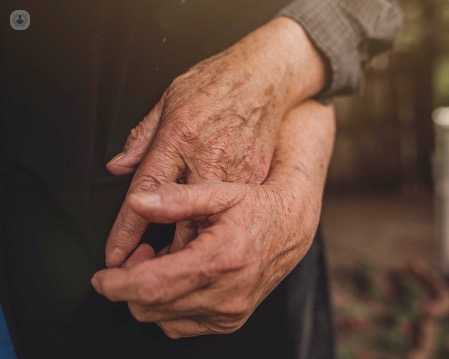Radiotherapy for Dupuytren’s contracture
Written by:Dupuytren's disease is a benign, slowly progressive condition that causes hand deformity. Origins of this disease are unknown, however, it affects men more than women and is also more commonly found in people of northern European descent. Roughly 1 in 6 men in the UK over the age of 65 have some degree of Dupuytren's contracture.

Luckily, with the help of a highly experienced clinical oncologist such as Dr Richard Shaffer, this condition can be treated effectively. In this article, we discuss how radiotherapy can be a solution, how it works, its success rate and what can be expected before, during and after radiotherapy.
How does it work?
The radiation is aimed towards the nodules caused by Dupuytren's disease to soften and shrink the lumps. The treatment also prevents the formation of contractures. Radiotherapy reduces the growth of cords under the skin and nodules by affecting the development and growth rate of fibroblasts. These are cells that are responsible for creating the lumps in the connective tissue. Radiotherapy also has anti-inflammatory effects and reduces inflammation around the cords and nodules. It reduces pain in the area treated too.
Who is suitable for radiotherapy?
Radiotherapy is best at treating the early stages of progressive Dupuytren's contracture—when there is minimal to no bending of your fingers and when it has worsened over the past 12 months. These are the recommended guidelines by The Royal College of Radiologists, who state that radiotherapy is effective in the early stage of Dupuytren's contracture, usually when there is no contracture or a minor contracture of up to 10 degrees.
If your contracture happens to be at an angle greater than 10 degrees, radiotherapy is likely to not be the best treatment for you. Your doctor may recommend alternative options.
How effective is radiotherapy for Dupuytren's disease?
In a long-term follow-up of a study, the outcomes of patients who had received radiotherapy for progressive Dupuytren's contracture was compared with patients who chose to be observed rather than treated.
Overall, the patients who received radiotherapy for the treatment of Dupuytren's contracture were over three times less likely to see their condition progress or need surgery to release a contracture. Please find the results below:
The results of the 8-year follow-up after radiotherapy for Dupuytren’s contracture:
|
Patient Treatment |
Improvement or no change in disease (%) |
Worsening of disease (%) |
Needed surgery for a contracture (%) |
|
No radiotherapy |
38 |
62 |
30 |
|
Radiotherapy |
60 |
20 |
8 |
Figure 1
What else can be expected from radiotherapy for Dupuytren’s contracture?
Prior to making a decision as to whether you should have radiotherapy, you will need to book a consultation.
During the consultation:
- The consultant will ask you questions. They will perform an examination, and they will discuss treatment options with you. It's essential that both benefits, and possible side effects, are clarified.
- If radiotherapy is decided, you'll need to sign a consent form before undergoing treatment.
- The consultant will then outline nodules and cords, which are also to be treated.
- A safety margin is marked around the tissue that's going to be treated. This helps ensure that the affected area will be treated accurately, and it will also protect the unaffected part of your hand.
- A radiographer will take a photograph of the area afterwards, and they'll make a tracing so that the area can accurately be treated each day.
- After this has been done, you can go home. Treatment will generally start at least a few days later.
During radiotherapy treatment:
- You'll need to position yourself under a radiotherapy machine, the hands will be placed on a positioning bag during the treatment.
- Each appointment takes around 10 minutes each day, with the radiotherapy treatment itself taking just under a minute to complete.
Radiotherapy for Dupuytren's disease is administered over five consecutive days (excluding weekends) and then also repeated after a three-month break.
Radiotherapy will also be targeted to the same area throughout your course of treatment—even if the nodules in the hand seem to be getting smaller. This is done in order to limit the likelihood of recurrence after treatment.
Post radiotherapy treatment:
You'll receive a follow-up call from us to check how you're doing after your treatment – you can discuss any side effects, problems or ask any questions.
Your consultant will send you a questionnaire three months after the treatment to later assess how your hands are. If it's necessary, you'll be able to have an additional consultation over the phone, via e-Consultation or a face-to-face appointment at one of our clinics. The outcomes of your treatment will be discussed in detail.
What are the risks of radiotherapy?
Minor side effects are sometimes experienced if you have radiotherapy treatment. This risk will be discussed with you during your initial consultation with my team. During the radiotherapy treatment itself, you shouldn't experience any side effects.
Short-term side effects:
Two to three weeks after your radiotherapy sessions has been done, the skin on your palm can become slightly red, dry or sore. It tends to be minor, although about 1 in 100 people can get weeping or swelling around the area.
Usually, putting some moisturiser on the area can sufficiently treat the dryness.
Long-term side effects:
Approximately one in five people find that the dryness will continue. Some people notice small changes in the skin, such as it being thicker, thinner, rougher, or smoother than how it was before the radiotherapy.
Whilst there is a theoretical risk of developing cancer in the skin around the treated area, this risk is very small. It's important to note that the radiation dosage is significantly lower than radiotherapy for malignant diseases.
If you will require treatment for Dupuytren’s disease, we recommend getting in contact with a leading oncologist such as Dr Shaffer. Click here for information on his areas of expertise, and appointment availability.
1. Seegenschmiedt, Michael Heinrich, et al. "Long-term outcome of radiotherapy for early stage Dupuytren’s disease: a phase III clinical study." Dupuytren’s disease and related hyperproliferative disorders. Springer, Berlin, Heidelberg, 2012. 349-371.


